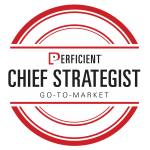Thrilling our clients with innovation and impact – it’s not just rhetoric. This belief is instrumental for our clients’ success. In 2018, we announced the first class of Chief Strategists, who provide vision and leadership to help our clients remain competitive. Get to know each of our strategists as they share their unique insights on their areas of expertise.
 A strong go-to-market strategy is essential for successfully bringing new products or services to customers who need them. Well planned go-to-market strategies provide a broad understanding of customer demand, gaps in competitive offerings or capabilities, and the strengths of your company and its products. They also support your enterprise’s overall growth and provide distinction in the marketplace.
A strong go-to-market strategy is essential for successfully bringing new products or services to customers who need them. Well planned go-to-market strategies provide a broad understanding of customer demand, gaps in competitive offerings or capabilities, and the strengths of your company and its products. They also support your enterprise’s overall growth and provide distinction in the marketplace.
Allison Fries, Go-to-Market Chief Strategist, has more than 18 years’ experience bringing products to market including considerable proficiency with launching consumer healthcare products and identifying new market opportunities for companies in telecommunications and retail.
We recently spoke to Allison and learned more about her goals as a Chief Strategist, her perspective on successful go-to-market strategies, and her life beyond the world of strategy.
 What does your role as a Chief Strategist entail?
What does your role as a Chief Strategist entail?
Allison Fries: As Chief Strategist, I specialize in go-to-market strategy and implementations. Perficient has partnerships with major technology vendors that offer a wide variety of solutions. However, I provide custom solutions for clients from an agnostic perspective. To do that, I look at a client’s key initiatives, challenges, organizational structure, budget, and existing technologies. These points are critical in deciphering what is best for our client.
What do you hope to accomplish as a Chief Strategist?
AF: One of my biggest goals is helping clients understand their options. For example, we have many clients looking for assistance with their cloud strategy. There are countless partners, solutions, and technologies in that space, and the decision to adopt one or the other can be daunting for some companies. They need to know about the benefits and challenges of the solution as well as its requirements.
I am also eager to provide thought leadership for our guides, blog posts, and at speaking engagements. Perficient has many stories to tell, and I am proud to help share our knowledge.
Strategically Speaking
Why does a go-to-market strategy matter for businesses?
AF: Go-to-market is strategy. Customers need to know how your business provides value. If a customer doesn’t have a good experience, they’re not coming back. The customer experience, especially from a digital perspective, is a massive component of an overall go-to-market strategy.
Some enterprises are in survival mode while others lead the market. To stay ahead, you must be able to scale your business and stay agile while growing with your customers. As technology evolves and markets shift, you must be nimble enough to pivot your strategy and teams to meet the needs of your customers.
What advice or tips do you have for developing a strategy?
AF: Your enterprise needs a starting point to understand where it fits in the market and what your customers want. You also need to consider your competitors – what they are doing and the gaps in their offerings.
Knowing your strengths as a brand is as important as listening to customers’ needs. For example, at Perficient, our value proposition remains that we are the right size company to meet our customers’ needs. We know this is true because our clients repeatedly say how important this aspect is and that it sets us apart from our competition.
Think Like a Chief Strategist
Tell us about a recent project you’ve tackled. How did we help the client achieve success?
AF: We recently worked with a startup satellite company that uses a global satellite-based system to allow tracking and monitoring of aircraft around the globe in real time. The challenge our client faced was they had this amazing product, but no customers yet. They needed a full go-to-market strategy to determine viable use cases, ideal customers, value proposition, and price considerations.
We helped our client understand and identify use cases that then determined potential customer segments. From there, we developed a strategic pricing model to recommend the right pricing based on customer attributes, product performance, type of data offering, and other pricing differentiators.
After developing the go-to-market strategy, we worked with our Strategic Advisory team to develop the technology plan. This included identifying the various technologies needed to execute the strategy and a development roadmap to provide customers access to their satellite data. The company can now grow in profitability with their new product and service line.
This example reveals how developing a go-to-market plan provided collaboration opportunities across Perficient to deliver an end-to-end solution for our client.
What questions do you ask clients when creating a go-to-market strategy?
AF: Go-to-market strategies are about identifying your ideal customer and why s/he needs your product or service. They let you see where you stand against the competition. Here are questions that provide a framework for your go-to-market strategy:
- What are the products?
- Evaluate and prioritize use cases for:
- Where the market is trending
- What customers are demanding
- How to measure level of benefit/effort
- Who will buy it?
- Identify customer segments
- Understand or anticipate customer demand
- Examine our competitors’ offerings
- Why will they buy it?
- Review the competitive landscape and value propositions
- Identify perceived benefits/unique value propositions for each use case
- Pinpoint customers’ technology requirements
- How will we get it to them?
- Partner or create
- Distribution model options
- Pricing options
- Packaging
- Supplier technology requirements
- Marketing
- Customer ease of use
- Bundling
- Evaluate and prioritize use cases for:
Beyond the World of Strategy
What are your interests or hobbies when you’re not wearing the Chief Strategist hat?
AF: My family is always first. I have a 13-year-old daughter and a 10-year-old son, who are incredible and keep me extremely busy. They’re sports oriented and very active in their schools, so my life is focused on driving back and forth to volleyball, hockey, and lacrosse practices and games.
I’ve run a number of marathons, each of them with my dad, which is really special to me. My dad just ran his 70th marathon in 2017, and I was fortunate enough to cross the finish line with him. His goal was to run in 70 marathons by the time he turned 70-years-old.
Community is also incredibly important to me. I serve on the board of We Don’t Waste, a nonprofit that reclaims food that would otherwise be discarded. The organization redistributes the food to those who are hungry. It’s a very unique supply chain organization that transports food from those who no longer need it to those who do.
In fact, Perficient’s management consulting team and supply chain team in Denver has been incredibly generous with volunteering their time. The organization recently built a warehouse, and our colleagues donated their time to plan and lay out the warehouse just perfectly. We are also working on a go-to-market strategy for the nonprofit. For me, it has been incredibly rewarding to be part of this organization.
Follow along on this series to learn more about each of our Chief Strategists. And, take a look at recent blog posts they’ve written on trending topics for their industries.

